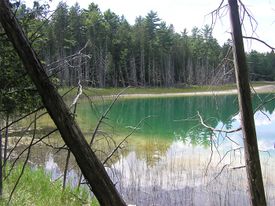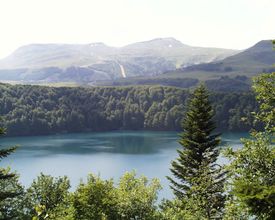بحيرة غير مختلطة الطبقات
البحيرة غير مختلطة الطبقات أو البحيرة المـِرومـِكتية meromictic lake يكون فيها طبقات من الماء لا تختلط ببعضها البعض.[1] في المعتاد، "البحيرات holomictic"، فعلى الأقل في مرة بالسنة، يحدث خلط فيزيائي لمياه السطح والمياه العميقة.[2]

المصطلح "مـِرومـِكتي" صاغه العالم النمساوي إنگو فيندنگ في 1935، بانياً إياه فيما يبدو على الكلمة الأقدم "هولومـِكتي holomictic". المفاهيم والمصطلحات المستخدمة في وصف البحيرات المرومكتية كانوا أساساً بالكامل يقتفون اضافات ج. إڤلن هتشنسون في 1937.[3][4][5]
. . . . . . . . . . . . . . . . . . . . . . . . . . . . . . . . . . . . . . . . . . . . . . . . . . . . . . . . . . . . . . . . . . . . . . . . . . . . . . . . . . . . . . . . . . . . . . . . . . . . . . . . . . . . . . . . . . . . . . . . . . . . . . . . . . . . . . . . . . . . . . . . . . . . . . . . . . . . . . . . . . . . . . . .
السمات
معظم البحيرات هي holomictic؛ أي أنها، على الأقل لمرة في السنة، يحدث فيها اختلاط فيزيائي بين السطح والمياه العميقة. In so-called monomictic lakes, the mixing occurs once per year; in dimictic lakes, the mixing occurs twice a year (typically spring and autumn), and in polymictic lakes, the mixing occurs several times a year. In meromictic lakes, however, the layers of the lake water can remain unmixed for years, decades, or centuries.
Meromictic lakes can usually be divided into three sections or layers. The bottom layer is known as the monimolimnion; the waters in this portion of the lake circulate little, and are generally hypoxic and saltier than the rest of the lake. The top layer is called the mixolimnion, and essentially behaves like a holomictic lake. The area in between is referred to as the chemocline.[6]
The lack of mixing between layers creates radically different environments for organisms to live in: among the consequences of this stratification, or stable layering, of lake waters is that the bottom layer receives little oxygen from the atmosphere, hence becomes depleted of oxygen. While the surface layer may have 10 mg/L or more dissolved oxygen in summer, the depths of a meromictic lake can have less than 1 mg/L.[7] Very few organisms can live in such an oxygen-poor environment. One exception is purple sulfur bacteria. These bacteria, commonly found at the top of the monimolimnion in such lakes, use sulfur compounds such as sulfides in photosynthesis. These compounds are produced by decomposition of organic sediments in oxygen-poor environments. The monimolimnion is often rich in phosphorus and nitrogen. These factors combine to create an ideal environment for bacterial growth. The mixolimnion can have similar qualities. However, the types of bacteria that can grow at the surface are determined by the amount of light received at the surface.[8]
البحيرة المـِرومـِكتية قد تتشكل لعدد من الأسباب:
- The basin is unusually deep and steep-sided compared to the lake's surface area
- The lower layer of the lake is highly saline and denser than the upper layers of water
The layers of sediment at the bottom of a meromictic lake remain relatively undisturbed because there is little physical mixing and few living organisms to agitate them. There is also little chemical decomposition. For this reason, cores of the sediment at the bottom of meromictic lakes are important in tracing past changes in climate at the lake, by examining trapped pollen grains and the types of sediments [see Proxy (climate)].
When the layers do mix for whatever reason, the consequences can be devastating for organisms that normally live in the mixolimnion. This layer is usually much smaller in volume than the monimolimnion. When the layers mix, the oxygen concentration at the surface will decrease dramatically. This can result in the death of many organisms, such as fish, that require oxygen.
Occasionally, carbon dioxide (CO2) or other dissolved gases can build up relatively undisturbed in the lower layers of a meromictic lake. When the stratification is disturbed, as could happen from an earthquake, a limnic eruption may result. In 1986, a notable event of this type took place at Lake Nyos in Cameroon, causing nearly 1,800 deaths.[9]
While it is mainly lakes that are meromictic, the world's largest meromictic basin is the Black Sea. The deep waters below 50 metres (150 feet) do not mix with the upper layers that receive oxygen from the atmosphere. As a result, over 90% of the deeper Black Sea volume is anoxic water. The Caspian Sea is anoxic below 100 metres (300 feet). The Baltic Sea is persistently stratified, with dense, highly saline water comprising the bottom layer, and large areas of hypoxic sediments (see Baltic Sea hypoxia).
قائمة البحيرات غير مختلطة الطبقات
توجد بحيرات مرومكتية في جميع أنحاء العالم. توريعهم يبدو في عناقيد، ولكن ذلك قد يكون بسبب عدم اكتمال تحقيقاتنا. فبالاعتماد على التعريف الدقيق لـ"مرومـِكتي"، فإن النسبة بين البحيرات المرومكتية والهولومكتية في أرجاء العالم هو تقريباً 1:1000.[10]
أفريقيا
- بحيرة نيوس و بحيرة مونون في الكامرون
- بحيرة كيڤو في رواندا و جمهورية الكونغو الديمقراطية
- بحيرة تنگانيقا في بوروندي وجمهورية الكونغو الديمقراطية و تنزانيا و زامبيا
- بحيرة ملاوي في أفريقيا، تقع بين ملاوي وموزمبيق و تنزانيا.
آسيا
الهامش
- ^ Wetzel, Robert G. (2001). Limnology: Lake and River Ecosystems (Third ed.). New York: Academic Press. ISBN 978-0-12-744760-5.
- ^ Lewis, William M., Jr. (1983). "A revised classification of lakes based on mixing" (PDF). Canadian Journal of Fisheries and Aquatic Sciences. 40 (10): 1779–1787. doi:10.1139/f83-207. Archived from the original (PDF) on 6 March 2009.
{{cite journal}}: Unknown parameter|deadurl=ignored (|url-status=suggested) (help)CS1 maint: multiple names: authors list (link) - ^ Hakala, Anu (27 February 2004). "Meromixis as a part of lake evolution – observations and a revised classification of true meromictic lakes in Finland" (PDF). Boreal Environmental Research. 9: 37–53. ISSN 1239-6095.
- ^ Findenegg, Ingo (1935). "Limnologische Untersuchungen im Kärntner Seengebiete. Ein Beitrag zur Kenntnis des Stoffhaushaltes in Alpenseen". Internationale Revue der Gesamte Hydrobiologie (in الألمانية). 32: 369–423. As cited by Hakala (2004).
- ^ Hutchinson, G. Evelyn (1937). "A contribution to the limnology of arid regions". Transactions of the Connecticut Academy of Arts and Sciences. 33: 47–132. As cited by Hakala (2004).
- ^ Walker, K. F. (March 1974). "The Stability of Meromictic Lakes in Central Washington". Limnology and Oceanography. 19 (2): 209–222. doi:10.4319/lo.1974.19.2.0209. JSTOR 2834407.
- ^ Lampert, Winfried; Sommer, Ulrich (1997). Limnoecology: The Ecology of Lakes and Streams. Translated by James F. Haney. Oxford University Press. ISBN 978-0-19-509592-0.
{{cite book}}: Unknown parameter|last-author-amp=ignored (|name-list-style=suggested) (help) - ^ Fry, Brian (January 1986). "Sources of Carbon and Sulfur Nutrition for Consumers in Three Meromictic Lakes of New York State". Limnology and Oceanography. 31 (1): 79–88. doi:10.4319/lo.1986.31.1.0079. JSTOR 2836641.
- ^ Krajick, Kevin (September 2003). "Defusing Africa's Killer Lakes". Smithsonian Magazine. Archived from the original on 2012-05-25.
{{cite journal}}: Unknown parameter|dead-url=ignored (|url-status=suggested) (help) - ^ قالب:Cite dissertation
خطأ استشهاد: الوسم <ref> ذو الاسم "Likens2010" المُعرّف في <references> غير مستخدم في النص السابق.
خطأ استشهاد: الوسم <ref> ذو الاسم "Jacquet2003" المُعرّف في <references> غير مستخدم في النص السابق.
خطأ استشهاد: الوسم <ref> ذو الاسم "Anderson1958" المُعرّف في <references> غير مستخدم في النص السابق.
خطأ استشهاد: الوسم <ref> ذو الاسم "Sanderson" المُعرّف في <references> غير مستخدم في النص السابق.
خطأ استشهاد: الوسم <ref> ذو الاسم "Mccoy" المُعرّف في <references> غير مستخدم في النص السابق.
خطأ استشهاد: الوسم <ref> ذو الاسم "NPSPicRocks" المُعرّف في <references> غير مستخدم في النص السابق.
خطأ استشهاد: الوسم <ref> ذو الاسم "WeimarLee" المُعرّف في <references> غير مستخدم في النص السابق.
خطأ استشهاد: الوسم <ref> ذو الاسم "CloernCole" المُعرّف في <references> غير مستخدم في النص السابق.
خطأ استشهاد: الوسم <ref> ذو الاسم "ParkinBrock" المُعرّف في <references> غير مستخدم في النص السابق.
<ref> ذو الاسم "CtrBioAlpina" المُعرّف في <references> غير مستخدم في النص السابق.وصلات خارجية
- "Density Stratification", part of an educational website Water on the Web operated by the University of Minnesota, Duluth. Retrieved 11-March-2007.
- Lake Fidler revived
- photo-outing.com review over Pantai Kerachut with Memomictic lake
